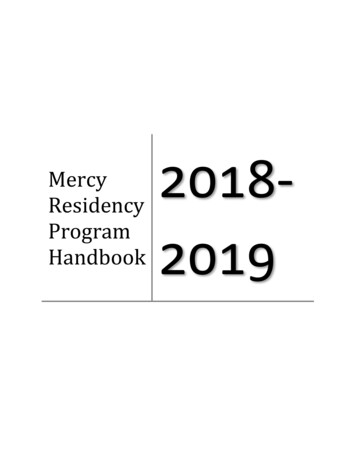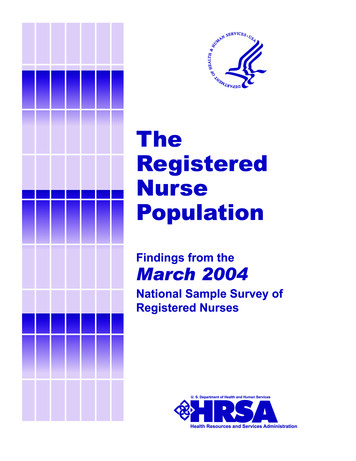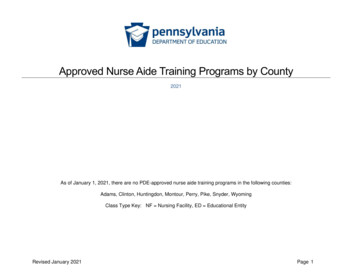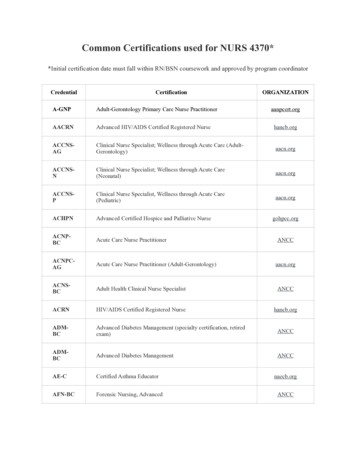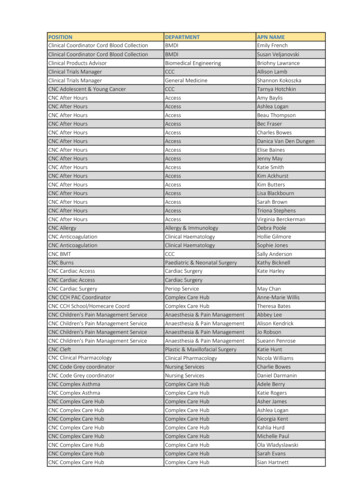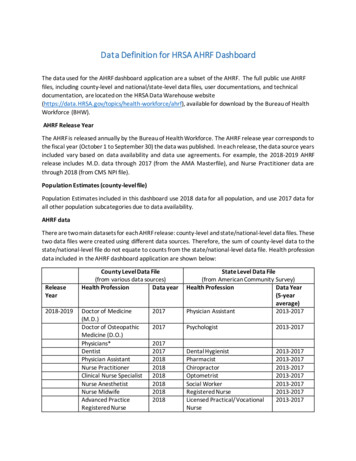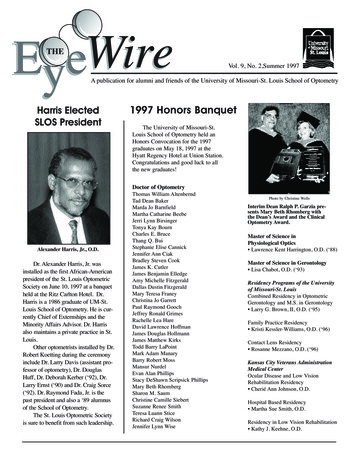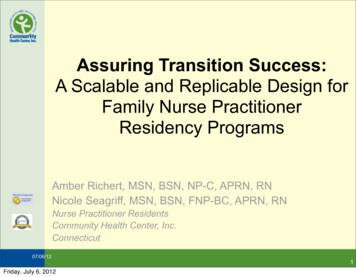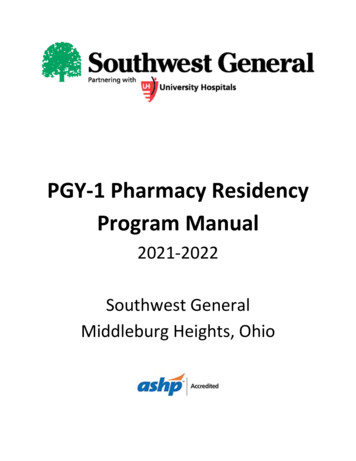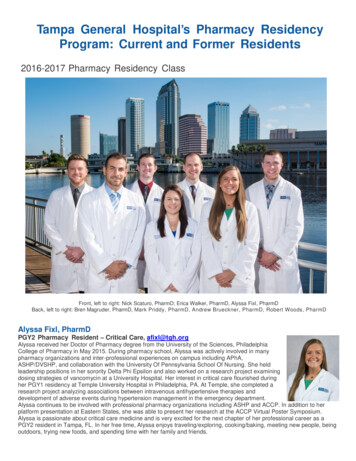
Transcription
JNPDJournal for Nurses in Professional Development Volume 35, Number 4, 185–192 Copyright 2019 Wolters Kluwer Health, Inc. All rights reserved.Nurse Residency Programs1.5 ANCCContactHoursKey Components for SustainabilityKimberly J. Chant, MSN, RN Denise S. Westendorf, MSN, RN-BCThe purpose of this integrative literature review was toidentify commonalities among nurse residency programsdeployed for greater than 3 years, showing improved jobretention and satisfaction. The Johns Hopkins NursingEvidence-Based Practice Model guided this review.Successful, sustainable nurse residency programs have astrong foundation with committed leadership to supporttransition; a structured program with defined outcomes topromote clinical competence, safe patient care, andprofessional development; and an evaluation process toguide continual improvement and meet organizational needs.“Nursing is the hardest job you will ever love.”This commonly heard statement from seasoned nurses speaks of wisdom that only yearsof practice can bring. Seasoned nurses are retiring or leaving the profession faster than new nurses are graduating.The Bureau of Labor Statistics for 2012–2022 predict that525,000 retiring nurses, combined with a job growth of19%, will create a need for 1.05 million new nurses by2022 (Rosseter, 2014). In the midst of such a nursing shortage, the greatest challenge lies in developing the next generation of professionals as efficiently as possible.The expertise required of a nurse in the hospital settingis gained through experiential learning, yet without accessto a residency program, new nurses are no longer affordedthat privilege. Rather than being nurtured in entry-level settings, new nurses are hired directly into high-paced, highdemand positions (Rush, Adamack, Gordon, Lilly, & Janke,2013). These newly qualified nurses bring a baseline of knowledge and an eagerness to learn, but they are transitioninginto practice with inadequate preparation (Letourneau &Kimberly J. Chant, MSN, RN, is Coordinator for Nursing Professional Practice, UnityPoint Health Trinity Regional Medical Center, Rock Island, Illinois.Denise S. Westendorf, MSN, RN-BC, is Associate Professor, Trinity Collegeof Nursing & Health Sciences, Rock Island, Illinois.Fater, 2015). Staffing challenges and burdens put on newnurses have led to increased stress levels with decreasedjob satisfaction; a striking 37% of new nurses leave the profession by their second anniversary (Rosseter, 2014).The Institute of Medicine report (IOM, 2011) The Futureof Nursing recommended nurse residency programs (NRPs)to support newly qualified nurses' transition into practice. Isnurse residency the best way to retain new nurses? Manymodels and programs have been developed in responseto the IOM's call for action. Evidence in practice has identified that NRPs can be effective in improving nurse retentionand job satisfaction (Cline, LaFrentz, & Fellman, 2017).An examination of the literature revealed that NRPshave assisted in improving nurse retention and job satisfaction (Chappell & Richards, 2015; Dwyer & Hunter Revell,2016; Fiedler, Read, Lane, Hicks, & Jegier, 2014). However,a deeper analysis of the literature exposed extensive variability in theory, design, implementation, evaluation, andoutcomes of NRPs. This variability limited the methodology of analysis and conclusions that can be drawn regarding best practices in NRPs (Anderson, Hair, & Todero, 2012,Rush et al., 2013). One author recommended that standardized or commercially available programs are criticalfor success (Cochran, 2017). Other opinions suggested thathospitals or healthcare organizations would do better toutilize an internally developed residency program to achievesimilar outcomes (Cline et al., 2017; Edwards, Hawker,Carrier, & Rees, 2015). This article adds to the literature anextrapolation of the evidence into a concise framework fordeveloping a hybrid or standardized model that will bringsustainable success in designing a NRP.The evidence-based practice (EBP) question was identifiedand developed based on professional experiences in planningand executing NRPs and a preliminary examination of the evidence. The research question was the following: In NRPs inexistence for 3 years or longer that have shown improvementin newly qualified nurse retention and job satisfaction, whatcomponents are vital in developing a sustainable program?The authors declare no conflicts of interest.METHODADDRESS FOR CORRESPONDENCE: Kimberly J. Chant, HR–OrganizationalDevelopment, 2701 17th Street, Rock Island, IL 61201 (e‐mail: Kimberly.chant@unitypoint.org).The Johns Hopkins Nursing Evidence-Based Practice(JHNEBP) Model (Table 1) was used with permission (KimBissett, personal communication, May 31, 2018) to guidethe integrative review. The JHNEBP Practice QuestionEvidence-Translation process guided each step of the review (Poe & White, 2010).Supplemental digital content is available for this article. Direct URL citationsappear in the printed text and are provided in the HTML and PDF versionsof this article on the journal's Web site (www.jnpdonline.com).DOI: 10.1097/NND.0000000000000560Journal for Nurses in Professional DevelopmentCopyright 2019 Wolters Kluwer Health, Inc. All rights reserved.www.jnpdonline.com185
TABLE 1 Johns Hopkins Nursing Evidence-Based Practice ModelEvidence LevelsQuality RatingsLevel IExperimental study randomized controlled trial (RCT)Explanatory mixed-method design that includes only a Level Iquantitative studySystematic review of RCTs, with or without meta-analysisQuantitative studiesA: High quality: Consistent, generalizable results; sufficientsample size for the study design; adequate control; definitiveconclusions; consistent recommendations based oncomprehensive literature review that includes thorough referenceto scientific evidence.B: Good quality: Reasonably consistent results; sufficient samplesize for the study design; some control, fairly definitiveconclusions; reasonably consistent recommendations based onfairly comprehensive literature review that includes somereference to scientific evidence.C: Low quality or major flaws: Little evidence with inconsistentresults; insufficient sample size for the study design; conclusionscannot be drawn.Level IIQuasi-experimental studyExplanatory mixed-method design that includes only a Level IIquantitative studySystematic review of a combination of RCTs andquasi-experimental studies, or quasi-experimental studies only,with or without meta-analysisQualitative studiesNo commonly agreed-on principles exist for judging the quality ofqualitative studies. It is a subjective process based on the extent towhich study data contribute to synthesis and how muchinformation is known about the researchers' efforts to meet theappraisal criteria.For meta-synthesis, there is preliminary agreement that qualityassessments of individual studies should be made for synthesis toscreen out poor-quality studies.aA/B: High/Good quality: used for single studies andmeta-synthesis.bThe report discusses efforts to enhance or evaluate the quality ofthe data and the overall inquiry in sufficient detail and it describesthe specific techniques used to enhance the quality of the inquiry.Evidence of some or all of the following is found in the report: Transparency: Describes how information was documentedto justify decisions, how data were reviewed by others, andhow themes and categories were formulated. Diligence: Reads and rereads data to check interpretations;seeks opportunity to find multiple sources to corroborateevidence. Verification: The process of checking, confirming, andensuring methodologic coherence. Self-reflection and scrutiny: Being continuously aware ofhow a researcher's experiences, background, or prejudicesmight shape and bias analysis and interpretations. Participant-driven inquiry: Participants shape the scope andbreadth of questions; analysis and interpretation give voice tothose who participated. Insightful interpretation: Data and knowledge are linked inmeaningful ways to relevant literature.C: Low quality: studies contribute little to the overall review offindings and have few, if any, of the features listed for high/goodquality.Level IIINonexperimental studySystematic review or a combination of RCTs,quasi-experimental and nonexperimental studies, ornonexperimental studies only, with or without meta-analysisExploratory, convergent, or multiphasic mixed-methods studiesExplanatory mixed-method design that includes only aLevel III quantitative studyQualitative study /August 2019Copyright 2019 Wolters Kluwer Health, Inc. All rights reserved.
TABLE 1 Johns Hopkins Nursing Evidence-Based Practice Model, ContinuedEvidence LevelsQuality RatingsLevel IVOpinion of respected authorities and/or nationally recognizedexpert committees or census panels based on scientificevidenceIncludes: Clinical practice guidelinesConsensus panels/position statementsA: High quality: Material officially sponsored by a professional,public, or private organization or a government agency;documentation of a systematic literature search strategy;consistent results with sufficient numbers of well-designedstudies; criteria-based evaluation of overall scientific strength andquality of included studies and definitive conclusions; nationalexpertise clearly evident; developed or revised within the past5 years.B: Good quality: Material officially sponsored by a professional,public, or private organization or a government agency;reasonably thorough and appropriate systematic literature searchstrategy; reasonably consistent results, sufficient numbers ofwell-designed studies; evaluation of strengths and limitations ofincluded studies with fairly definitive conclusion; nationalexpertise clearly evident; developed or revised within the past5 years.C: Low quality or major flaws: Material not sponsored by anofficial organization or agency; undefined, poorly defined, orlimited literature search strategy; no evaluation of strengths andlimitations of included studies, insufficient evidence withinconsistent results, conclusions cannot be drawn; not revisedwithin the past 5 years.Level VBased on experiential and nonresearch evidenceIncludes: Integrative reviews Literature reviews Quality improvement, program, or financial evaluation Case reports Opinion of nationally recognized expert(s) based onexperiential evidenceOrganizational experience (quality improvement, program orfinancial evaluation)A: High quality: Clear aims and objectives; consistent resultsacross multiple settings; formal quality improvement, financial, orprogram evaluation methods used; definitive conclusions;consistent recommendations with thorough reference to scientificevidence.B: Good quality: Clear aims and objectives; consistent results in asingle setting; formal quality improvement, financial, or programevaluation methods used; reasonably consistentrecommendations with some reference to scientific evidence.C: Low quality or major flaws: Unclear or missing aims andobjectives; inconsistent results; poorly defined qualityimprovement, financial, or program evaluation methods;recommendations cannot be made.Integrative review, literature review, expert opinion, case reports,community standard, clinician experience, consumer preferenceA: High quality: Expertise is clearly evident; draws definitiveconclusions; provides logical argument for opinions.B: Good quality: Expertise appears to be credible; draws fairlydefinitive conclusions; provides logical argument for opinions.C: Low quality or major flaws: Expertise is not discernable or isdubious; conclusions cannot be Help/6 4 ASSESSMENT OF QUALITATIVE RESEARCH.htm.Adapted from Polit and Beck (2017).bSearch terms included new graduate nurs*, newly qualified nurs*, nurse residency, outcomes, retention, sustainment, transition, staffing turnover, and job satisfaction.Inclusion criteria consisted of peer-reviewed nursing EBPpublications dated from 2007, newer NRPs within hospitalacute care settings, programs sustained for 3 years orlonger with program evaluations and outcomes, and USor Canadian publications.A literature search was conducted in CINAHL, Mosby'sClinical Key, OVID, PubMed: Medline, and Sigma WileyOnline Library. Of the original 98 articles identified, 14were found to meet inclusion criteria. In addition, fourJournal for Nurses in Professional DevelopmentCopyright 2019 Wolters Kluwer Health, Inc. All rights reserved.www.jnpdonline.com187
FIGURE 1. Selection process for literature on nurse residency programs to identify key components of success and sustainability.specifically cited articles were searched and found to meetinclusion criteria. A total of 18 articles were retained for theintegrative review (Figure 1). The final 18 articles are presented with an asterisk in the references. Search selectionand data retrieval were conducted independently by thefirst author (see Supplemental Digital Content 1, http://links.lww.com/JNPD/A18). The second author verified thatarticle selection was conducted per protocol.RESULTSThis review indicated inconsistency among programs(Anderson et al., 2012; Edwards et al., 2015; Rush et al.,2013). The IOM recommended NRPs, but gave little direction as to how they should be structured (IOM, 2011). Theneed for consistency or a standardized process has beenrecommended in most of the literature reviewed.There have been several attempts at developing standardized programs, with the University HealthSystem Consortium/American Association of Colleges of Nursing (UHC/AACN)Model being the most prominent (Anderson et al., 2012,Chappell & Richards, 2015; Fiedler et al., 2014; Fink,Krugman, Casey, & Goode, 2008; Goode et al., 2013;Goode, Ponte, & Sullivan Havens, 2016; Rosenfeld et al.,2015; Van Camp & Chappy, 2017). Other successful programs include the Versant Model and the Transition toPractice Model (Chappell & Richards, 2015; Goode et al.,2016; Ulrich et al., 2010; Van Camp & Chappy, 2017).The conclusion by Edwards et al. (2015) was that the188model was not as important as staff support, which produced the desired outcomes. Spector and Echternacht(2010) recommended for nursing to come together to forma nationally standardized NRP. It was also recommendedthat all newly qualified nurses participate in an accreditedNRP (Goode et al., 2016).Key components to a successful NRP encompassed astrong foundation built on organizational leadership thatincluded a dedicated resource and healthy work environment, a structured program developed within a theoreticalframework that provided a curriculum designed to meetprogram objectives, and an evaluation process that utilizednurse resident feedback to guide improvements to theprogram (Figure 2).A Strong FoundationCritical to achieving lasting success of any undertaking wasa strong foundation built on organizational backing andcommitted leadership. Nurse residency programs can besuccessful with the proper support and resources. A program coordinator or dedicated resource was vital to maintaining momentum and consistency (Rush et al., 2013).Even more significant was the influence of authentic leadership in supporting positive transitional experiences fornew nurses (Dwyer & Hunter Revell, 2016). Essential toany successful model was this key person to facilitate coordination and teamwork with content experts. Most studiesfailed to identify this person or role; however, it waswww.jnpdonline.comJuly/August 2019Copyright 2019 Wolters Kluwer Health, Inc. All rights reserved.
FIGURE 2. Model of nurse residency programs: key components for sustainability.implied in the discussion of program facilitation and program costs (Goode et al., 2013; Ulrich et al., 2010).Healthy work environments were crucial to any focuson retention. Cochran (2017) described the healthy workenvironment as supporting effective communication, promoting professionalism, and nurturing a learning environment. In Magnet-designated hospitals, a strong nursingpresence promoted a positive work culture and peer support for new nurses (Goode et al., 2013). Other organizational factors such as structures that contribute to professionalpractice within the environment may influence new nurses'perceptions of workplace culture. For example, access togrowth opportunities, information, resources, and peer support were seen as positive influential factors (Dwyer &Hunter Revell, 2016). Healthy work environments affectfar more than the success of NRPs. All nurses are influenced by a healthy work environment, which plays a rolein the successful transition of new nurses into practice.A Structured ProgramFoundational framework/modelEvidence-based practice is essential to the development ofany program in nursing. Benner's (2001) novice-to-expertmodel is consistently cited in the literature as a foundational model on which many nursing programs and concepts are developed. Benner's (2001) model also servesas the framework on which the UHC/AACN, Versant, Transition to Practice, and custom-designed NRPs are built(Anderson et al., 2012; Rosenfeld et al., 2004; Spector &Echternacht, 2010; Ulrich et al., 2010). Benner (2001) presents an explanation to the way novice nurses develop critical thinking through experiential learning; also discussedis how these experiences eventually lead to the nurse'sability to clinically reason, a goal that has been identifiedfor most NRPs.Defined outcomesFurther development of an NRP framework included defined outcomes, as well as learning objectives geared toward the nurse residents. Ideally, the learning objectivesare what guide curriculum development (Anderson et al.,2012; Chappell & Richards, 2015; Cochran, 2017; Dwyer& Hunter Revell, 2016; Goode et al., 2016; Rush et al., 2013;Van Camp & Chappy, 2017). The evidence is clear that certain nursing competencies are necessary for a smooth transition into practice.The UHC/AACN model identified that the nurse woulddevelop clinical knowledge and skills to meet the demandsof professional nursing practice in an acute care setting(Rosenfeld et al., 2004). The Versant Model was designedto assist nurses to become confident and provide competent, safe patient care (Ulrich et al., 2010). The Transitionto Practice model by Spector and Echternacht (2010) identified program objectives to include clinical reasoning andpatient safety. Other desired outcomes focused on the development of clinical leadership, safe patient care, and professional development (Cline et al., 2017; Kramer et al.,2012). Cochran (2017) pointed out that it is also importantto consider the needs of the new nurses themselves so asto feel supported and declare their intent to stay with the organization. Overall, NRPs designed with well-defined goalscan be influential in transitioning a new nurse into professional practice.Analysis of NRPs from the literature revealed certaincommonalities that appear to be key in achieving success.The curriculum of successful NRPs included trained preceptors, dedicated mentors, a didactic component thatJournal for Nurses in Professional DevelopmentCopyright 2019 Wolters Kluwer Health, Inc. All rights reserved.www.jnpdonline.com189
included opportunity for peer socialization, and a correlatedclinical immersion. Other influential modalities included adetermined program length, most commonly 12 months,and a robust evaluation process, which was critical forsustainability.Trained preceptorsTraditional to nursing orientation are trained preceptors.The literature indicated that this person-to-person relationship is critical for NRPs. Dwyer and Hunter Revell (2016)promoted that preceptors serve as leaders, helping to balance relationships and transition for the new nurse. Identified by Rush et al. (2013) as someone serving in this looselydefined role of trainer, resource, support, and mentor, thepreceptor was also key to the socialization of the new nurse.Moreover, it was also recognized that nurse residentsdesired consistent preceptors to help foster relationshipsand skills development (Cochran, 2017; Fink et al., 2008).Training programs for preceptors should be formal and focus on authentic leadership including effective feedbackand communication (Dwyer & Hunter Revell, 2016; Rushet al., 2013).Offered as a variation to the traditional preceptor model,Ulrich et al. (2010) discussed the concept of team precepting as used in the Versant Model. This innovative concept was designed to have a newer nurse serve in theprimary preceptor role, while overseen and mentored bya senior nurse. This model was found to benefit both thenewer preceptor in being supported, as well as preservingthe senior nurse from burn-out due to the continual demand(Ulrich et al., 2010). Kramer et al. (2012) recommended thatPreceptor Councils could provide structure and training thathave been determined to be crucial. Overall, most criticalwas the need for a well-developed preceptor-to-nurse relationship to facilitate transition into practice (Spector &Echternacht, 2010).Dedicated mentorsNurse residency programs promote an ongoing relationship beyond the initial preceptor period (Anderson et al.,2012; Cochran, 2017; Rush et al., 2013). Defined mentor relationships were just as crucial to the successful transitionof new nurses as preceptors (Anderson et al., 2012; Edwardset al., 2015; Rosenfeld et al., 2004). Mentors encouraged critical thinking and provided feedback and support for extended periods of time beyond the initial training period(Edwards et al., 2015; Rosenfeld et al., 2004; Spector &Echternacht, 2010). Ulrich et al. (2010) suggested thatmentoring with debriefing should include structured sessions with guidelines to provide specific focus for discussions. Ultimately, mentors model professionalism and instillconfidence in the new nurse, as well as provide stabilityand sustainability to NRPs.190Didactic componentThe general consensus from the literature was that a didactic component is vital to NRPs. The UHC/AACN, Versant,and Transition to Practice NRP models promoted a standardized curriculum that is evidence-based (Anderson et al., 2012;Goode et al., 2016; Spector & Echternacht, 2010; Ulrich et al.,2010). Features of the UHC/AACN model focused on leadership skills, patient outcomes, and professional roles (Andersonet al., 2012). The Versant Model included classroom withcase studies, team precepting to guide a structured clinicalimmersion, arranged mentoring-debriefing, and competency validation (Ulrich et al., 2010). In the Transition toPractice Model, Spector and Echternacht (2010) promotedfive modules for experiential learning: patient-centeredcare, communication and teamwork, EBP, quality improvement, and informatics. Other evidence-based elementsessential for transition into practice included case studiesto promote clinical reasoning, delegation, communication,conflict resolution, prioritization, and peer support (Goodeet al., 2013, 2016; Kramer et al., 2012). Didactic sessionswere commonly presented as monthly seminars promoting interaction with content experts and peer integration (Goode et al., 2016; Rosenfeld et al., 2015; Rushet al., 2013).Seminars inspired other benefits, such as building relationships within cohorts. Peer socialization fostered a senseof belonging, comradery, support, and teamwork (Andersonet al., 2012; Fink et al., 2008; Rosenfeld et al., 2015; Rush et al.,2013; Spector & Echternacht, 2010). Dwyer and HunterRevell (2016) discussed how this interpersonal influenceresulted in a psychological capital identified as PsyCap,thus creating a positive influence in self-confidence, optimism, hope in success, and resilience. Fink et al. (2008)suggested that nurse residents need more time to talk abouttheir concerns. Seminar sessions may be invaluable in developing nurse residents through education, training, andsocialization. Seminars cannot stand on their own; however,when paired with high-quality trained preceptors and mentors, the NRP seminar may be influential in a new nurses'transition into practice.Clinical immersionIt has been a longstanding tradition in nursing to provideclinical orientation. The literature focused on NRPs withkey elements designed to enrich this experience. For example, new nurses stated that starting out on their unit ofchoice could set the stage for a positive experience (Dwyer& Hunter Revell, 2016). Moreover, a consistent preceptorwas found to be helpful in providing uniformity in skillstraining (Fink et al., 2008). Clinical hands-on-learning ledto developing clinical competence, which resulted in a gradual integration into the professional practice role (Krameret al., 2012).www.jnpdonline.comJuly/August 2019Copyright 2019 Wolters Kluwer Health, Inc. All rights reserved.
Clinical competence develops over time. First, with critical thinking, a nurse learns to weigh the options againstthe evidence to make a clinical decision. Clinical judgmentis then acted upon through nursing interventions, followedby reassessment of the results. The cycle then repeats itself.It is through this experiential learning that a nurse developsclinical competence (Benner, 2001; Ulrich, 2012). Nurse residency programs may provide a strong nurse–preceptor relationship, instructional support through didactic sessions,and well-coordinated clinical experiences. This perfect trifecta is what fosters clinical competence, identified in theliterature as clinical leadership skills, patient safety, andprofessional development (Anderson et al., 2012; Dwyer &Hunter Revell, 2016; Fink et al., 2008; Goode et al., 2016;Kramer et al., 2012; Rush et al., 2013, Spector & Echternacht,2010; Ulrich et al., 2010).Program lengthNurse residency programs typically extended the length ofa traditional orientation program in order to achieve desired outcomes. There was much variation in the literatureas to what is an ideal length. The average was 12 months,as reflected in the UHC/AACN, Versant, and Transition toPractice models (Goode et al., 2013; Spector & Echternacht,2010; Ulrich et al., 2010). Other program suggestions rangedfrom 6 to 24 months, stating considerations related to Benner'stransition stages and issues related to reality shock with conflictresolution (Anderson et al., 2012; Chappell & Richards, 2015;Letourneau & Fater, 2015; Kramer et al., 2012; Rosenfeldet al., 2004; Rush et al., 2013).Benner (2001) identified the initial transition from novice to advance beginner to last about 12 months. Anotherimportant consideration in meeting the transitional needsof the new nurse was Marlene Kramer's (1974) seminalwork on understanding why nurses leave nursing, identified as reality shock. A very real phenomenon, Kramer(1974) suggested that it takes new nurses a minimum of12 months to transition through this course of rationalizingthe reality of what they believed nursing to be and what ittruly is. Clearly, variables such as maturity, life experiences,and the actual orientation experience impact conflict resolution and transition through reality shock (Cochran, 2017;Kramer, 1974). Ultimately, NRPs need to provide newnurses with transitional support, as well as achieve otherprogram outcomes.An Evaluation ProcessConsistent evaluation of any process improvement or programis critical to maintaining value and sustainability (Sherwood& Barnsteiner, 2012). Nurse residency programs should havedefined outcomes with measurable goals attached to eachoutcome; typically, measurement occurs through data extracted from human resources' personnel records or throughsurvey instruments (Sherwood & Barnsteiner, 2012). Eacharticle in this integrative literature review discussed anevaluation process. The Casey-Fink Nurse Experience Survey was the most frequently used tool to assess programoutcomes due to its robust process for collecting unbiasedfeedback from nurse residents after program completion(Anderson et al., 2012; Chappell & Richards, 2015; Clineet al., 2017; Dwyer & Hunter Revell, 2016; Fink et al.,2008; Goode et al., 2013, 2016; Letourneau & Fater, 2015;Rush et al., 2013; Van Camp & Chappy, 2017). Evaluationwas consistently integrated throughout programs at 3, 6,9, and 12 months; resident feedback was utilized to continually improve the NRPs to meet the needs of the nurses, aswell as the organization (Anderson et al., 2012; Chappell &Richards, 2015; Cochran, 2017; Dwyer & Hunter Revell,2016; Edwards et al., 2015; Fiedler et al., 2014; Goodeet al., 2016; Rush et al., 2013; Van Camp & Chappy, 2017).The feedback and evaluation were critical to sustaining aprogram that continues to meet the needs of the nurse residents, as well as the organizational objectives.LimitationsThere were several limitations to this literature review.Only one primary reviewer conducted the literature review, thereby limiting interpretation of each article. In addition, the levels of evidence (Poe & White, 2010) for thearticles were considered a weakness. The integrative literature review consisted of qualitative studies, retrospective,expert opinion, and literature reviews. Moreover, therewas a lack of detail in program design, which limited theability to assess key components.DISCUSSIONThe evidence from this literature review suggests that NRPsare valued and produce results. Identifying the key components to successful and sustainable NRPs is most beneficialfor organizations invested in the retention and satisfactionof new nurses. Nurse residency programs require a strongfoundation consisting of committed and authentic leadership, a key coordinator, and a healthy work environment;a structured program developed on a nursing framework/model, defined outcomes, trained preceptors, mentors, a didactic component, and a specific program length; and a robust evaluation process based on a structured evaluationtool and consistent periodic feedback from the nurse residents to gu
Nurse Residency Programs Key Components for Sustainability Kimberly J. Chant, MSN, RN Denise S. Westendorf, MSN, RN-BC . a structured program with defined outcomes to promote clinical competence, safe patient care, and . (UHC/AACN) Model being the most prominent (Anderson et al., 2012, Chappell & Richards, 2015; Fiedler et al., 2014 .
